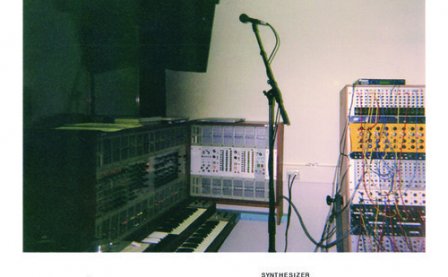During a long drive home from a Boredoms show in 2005, I remember getting into a sleep-deprived conversation with my friend about the night. Music was still ringing in my ears, and a feeling of giddy amazement hadn't let up as I rambled on about how great the experience was. Boredoms had rocked me thoroughly, and I was ready to tell anyone I could. Their set transcended simple ideas of 'song,' I said, and connected the band's entire late-period discography into a kind of huge cosmic ether. My friend agreed that it was easy to get lost in and submit to their sounds. You could forget most musical notions, he said, and open your mind to an unusually visceral experience. Case in point: hearing a Boredoms chord change doesn't invoke images of keys and a fretboard; it invokes nature -- crashing tides and exploding stars. I agreed as well and thought additional cosmic thoughts all the way home. It was a great night.
Now, that might sound hyperbolic, but if you've been to a Vooredoms/Boredoms show or heard a recent Boredoms album, you've probably felt a bit cosmic yourself. They connect to an almost religious groove located in your body, a meditative musical center that has its roots in minimalism, African polyrhythm, and more recently 'krautrock' acts like Can and Neu!. Inevitably, each Boredoms release is somewhat of an event, and fan interest was piqued after the announcement of a new installment in the ongoing Super Roots series, one that would package a 2004 live performance. Having recently succumbed to the live experience, I was predictably eager to hear the same set captured on disc. It would provide me with some perspective. Coming away from their last show, I couldn't begin to analyze the technical aspects of the music; my visceral reaction had been too strong. And perspective I got.
Throughout Super Roots 9, the drumming is plainly established as the Boredoms anchoring point, and the easiest gateway into their work. The three anchors, Yoshimi, ATR, and Youjiro, churn out the same percussive arrangement I saw live, almost hit for hit, shaping a pulsating ocean of drums for EYE's turntable manipulations to exist within. Concerning composition and execution, it's surprising how little the set changed. For 40 minutes, three mingling beats are locked in a constant dialog, pushing each other backwards and forwards in calculated chaos. I can't stress the overall organic nature of the pulse enough. It becomes clear that, despite Boredoms' otherworldly naturalism, their act was rehearsed and plotted rigorously and has probably been that way for a while. That they manage to sustain such immediacy from show to show is impressive, though conducive to joyous drum orchestrations, I'm sure.
Only on several occasions does the furious krautrock aesthetic wind down -- once for Yoshimi to flex her wordless vocals, once for EYE to highlight his turntabalism, and another for the drums to breathe. On the whole, Super Roots 9 is beautifully uniform in its execution, if not in its production quality. When listened to on loud speakers, turned way up, the disc represents some of the best Boredoms studio efforts and provides a fair portrait of their live show. Of course, as with any live disc, some magic is lost in translation. On headphones, particularly, a different picture is revealed. The drums become thin and compartmentalized, begging to be recorded with as much care and depth as 2004's Seadrum; EYE's yelps seem more distant; and the overall mix is flattened out.
Only one aspect of the performance, which has a potential though undeservedly novel effect, sounds clear and brilliant and great throughout, no matter where you're listening: the choir! After some cymbal and chime sweeps, the disc opens unexpectedly with a warm, shimmering vocal harmony. It surprised the hell out of me. Even though I knew the recorded show was to feature a full choral arrangement of EYE's turntable samples, I wasn't expecting it to gain such prominence, to subtly alter the Boredoms sound, to highlight odd moments or to cast a spotlight on recognizable harmony. All of which it does. Hearing a chorus of voices moving perfectly in step with the drum flow also brings you a little closer to Earth. Those are voices you can relate to, and their sound ushers additionally clear reference points. Vocal works from John Adams, Philip Glass, and Morton Feldman come to mind immediately, along with an exciting extra layer of tone.
I imagine if seen first hand, the choir's assimilation into the Boredoms sound would have been ten times as glorious as it is on disc. And in my most critical listening moments, I feel the same way about most elements of Super Roots 9. Yeah, the drums are kind of muffled and the mixing a bit bland. But keep listening, and keep turning it up. That's essential. Going through the album many times, I've come to a pretty firm verdict on Super Roots 9 or maybe an understanding: If I ever want to take a trip back in time, to another personal state of mind, I'll pop the disc in and go there for a bit. But when my memory starts to get fuzzy, and I can't remember what destroyed all my brain cells in the first place, I'll still have the disc for what it is -- and minus all the live experience correlation bullshit, what Super Roots 9 is is pretty phenomenal. It's rock music at its finest; it's modern krautrock; it's live Japanese experimentation; it's a relic that, if uncovered by a future generation, will be the coolest discovery ever.
1. LIVWE!!!
More about: Boredoms




